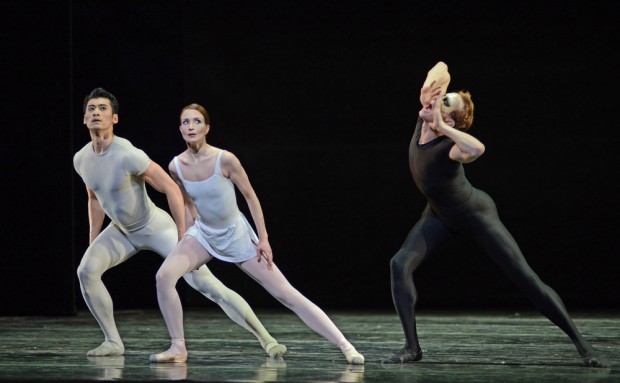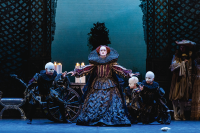Can you ballet-dance to words? How can choreography make any seriously worthwhile addition to a piece of music like Mahler’s vocal symphony Das Lied von der Erde? Kenneth MacMillan’s 1965 ballet Song of the Earth, currently on at Covent Garden, is frequently hailed as a masterpiece, but just as often you read comments by people baffled by it, lost in its length and orchestral density, and in their incomprehension of the German/Chinese verses that provided both composer and choreographer with their narratives.
The Royal Opera House authorities believed the exercise shouldn’t be attempted at all, and MacMillan, fresh in 1965 from the huge success of his new Romeo and Juliet (premiered by Fonteyn and Nureyev), quit the Royal Ballet to make it in Germany. So powerful was Song of the Earth, when it premiered in Stuttgart nine months after Romeo, that the Royal Ballet apologized and asked for it to come home. Exactly 50 years later it has passed its 100th London performance in the present run, which ends this Thursday.
Few choreographers dare to tackle music with words – words are full of traps, they can bully a choreographic imagination into emotive clichés, or Mickey-Mousing, or obscurantism. The leading American modern choreographer Trisha Brown, setting Schubert’s Winterreise for Simon Keenlyside some years back, confessed to me she felt overwhelmed by the expectation that she’d fail to answer for that extraordinarily dense bond between composer and his chosen poet.
You often see people asking for surtitles for Song of the Earth to help them understand this hour-long plotless piece via its lyrics. MacMillan knew the words intimately, he absorbed profoundly how Mahler had himself absorbed and subsumed the texts into his music. And that makes it the more provocative to the layperson to see how in the Royal Ballet’s current rehearsal trailer, Monica Mason and Grant Coyle rehearse three dancers in the great half-hour-long conclusion, Abschied, with hardly a single mention of the words – in fact, few indications of a vocal ingredient at all.
They rehearse in counts, the instructions being in dynamic accents: ‘Go!’, ‘Don’t stop!’, ‘A-a-and…‘, ‘ONE, two, three’. You might wonder, considering the intense literary experience of the poetic libretto, how this elliptical word-less shorthand can possibly lead to the profound dance expression it begs for. But it evidently does.
Even more strangely, sometimes the dance is actively contradictory to the words. For instance, there is a powerful dance image where the masked ‘Messenger of Death’, seems to shout through flared hands. But the music there is intense, quiet, and the words on that line are: ‘He spoke, and his voice was veiled.’
There’s another example where you’d be perplexed to see the words and the movement. ‘I wander, I seek peace for my lonely heart,’ murmurs the mezzo with aching sadness. And on the word ‘Ruhe’ (peace) the female dancer dashes across the stage and hurls herself horizontally like a javelin, caught midair by the two men, in a movement of wild speed, of rebellion, even. How confusing it would be to try to match image to word, or even image to the music.
If you read the text through, you’ll also notice how the poet’s narrative is of isolation, as one man waits to say goodbye to one last friend, before withdrawing from the physical world, in metaphorical death. There are only two men in the story. And yet this is not MacMillan’s narrative, which exploits the powerful emotional imagery of a trio tightly wrapped in physical exchanges.
The woman is poised, often lifted, swayed, or tied, in intricate interactions and phrases between, as it were, her living partner, in pale grey, and the masked man in black, who calls her (with that cupped mouth gesture) to death. However, if your ears are open to the instruments, rather than the singing, you hear how MacMillan is responding to the speaking exchanges of the flute, oboe and clarinet.
And as you study it, you see that while the mezzo in Abschied is silent for long stretches, the dance scenario must thread constantly through both vocal and some very extended instrumental episodes. In fact, it’s because Mahler lets loose of the words in this last song for such long periods to concentrate on the instrumental expression that MacMillan is released far more than in any of the other five songs to develop his own penetratingly emotional, independent scenario.
The funeral march before the singer resumes the third, final verse is the stand-out challenge – seven minutes long, turbulent, dark, intensely full of grief and foreboding, all wrung out by the time the long-awaited friend at last arrives in the text. He apparently does not know that the narrator – the ‘I’ – is dying, and asks, incomprehendingly, where he is going, and ‘why it must be’. In the text, the ‘hes’ are confusing, but the man who ‘sprach’ in that veiled voice is the doomed narrator, the dying man. And yet in MacMillan’s parallel dance scenario, it’s the messenger of death (or eternity) who calls, with that loudly registering flared trumpet gesture, calling the human into port.
So many differences with the verses and so much independence of Mahler’s musical structure. Were those Opera House authorities right to be chary of a choreographer’s intervention? Well, of course not. The emotional trajectory of MacMillan’s Song of the Earth is precisely answerable to that of Mahler’s Das Lied von der Erde, and the gorgeous, fatalistic musical loading the composer gave to the picturesque Chinese verses (themselves already adapted in translation into German).
At the lush climax, where the dying narrator declares he must go home, and that his heart now, calmly, ‘awaits its hour’, and the music swells in a major key as he concentrates on the burgeoning beauty of the earth, MacMillan puts his girl alone, at last. What can she do in dance to match this visionary, time-stopping trance of sound and meaning?
As you can see in the clip of Darcey Bussell’s performance with the Royal Ballet (above), she rises up on her pointes as if pulled by an invisible string, and in an incredible display of ballerina skilfulness runs backwards on pointe, seemingly blown by the wind. Her gestures of farewell echo those of the ballerina to her public at curtain call. The bourréeing itself is reminiscent (once again) of MacMillan’s Juliet, who seems embedded in this final part – her death, though, is now movingly transfigured from the fullstop tragedy of the previous story now into a blessed flight into the blue light of eternity. The enigmatic masked figure has proved to be a messenger of passage into eternity, a Dark Angel, who also echoes that wonderful death elegy by Balanchine, Serenade.
True, I feel that MacMillan’s dance inspiration does lapse in places into superficiality and cliché in the complex fourth and more simplistic fifth songs. But Abschied is where the Gesamtkunstwerk stands or falls.
By taking apart the synthesis of text, music and dance you discover amazing revelations about the peculiarly specialised intelligence of a great choreographer, and his ability to incorporate, cast away, and digest stimuli to his imaginative expression, all the while remaining entirely faithful to the impulses he felt in the first place. And it makes you think about the fragility of such a complex art, needing all these skills, such honesty, such mastery, when all of that may still not be enough.






Comments